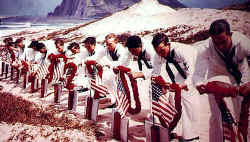Pearl Harbor World War II
For the United States, the Second World War started in Hawaii
with the attack on Pearl Harbor, December 7, 1941. Pearl Harbor
is a large Navy base and harbor on the south coast of the
island of Oahu. It was not the only place attacked by the
Japanese that day.
 Wheeler
Army Air Field in the center of the island was also attacked.
The Army was just as surprised and unprepared as the Navy.
Read Sergeant
Jack Spangler's account of getting bombed on his way to
breakfast. The only plane he shot down that day was a U.S.
Navy fighter. Wheeler
Army Air Field in the center of the island was also attacked.
The Army was just as surprised and unprepared as the Navy.
Read Sergeant
Jack Spangler's account of getting bombed on his way to
breakfast. The only plane he shot down that day was a U.S.
Navy fighter.
Navy Chief Petty Officer John
Finn was in bed with his wife at Naval Air Station Kaneohe
Bay when the Japanese planes struck. He drove to the hanger
and began removing machine guns from parked aircraft to fire
at the enemy. After the first attack, Chief Finn organized
his men and began setting up additional machine gun positions.
He finally got to the hospital the next day, and they kept
him until December 24th caring for his numerous wounds. Nine
months later Lieutenant John Finn was awarded the Medal of
Honor for his actions during the attack.

Eighteen people died at the Kaneohe Air base, and were buried
with full military honors and a Hawaiian flower lei.
The Japanese also attacked Marine
Corps Ewa Mooring Mast Field. The mooring mast refers
to a large pole used to moor airships (blimps) and dirigibles.
All the Marine aircraft were destroyed on the ground.

That same day, December 7, 1941, the Japanese forces also
attacked Midway Island, the westernmost island in the Hawaii
archipelago. First Lieutenant George Cannon, USMC, after being
injured by enemy shelling, refused to leave the command post
until his wounded men were safely evacuated. He died due to
a loss of blood and was posthumously awarded the Medal
of Honor.
The most unusual incident of December 7th was the crash landing
of a damaged Japanese fighter aircraft on the island Niihau,
southwest of Kauai. In this Niihau
Incident, 22-year-old Airman 1st Class Shigenori Nishikaichi
survived the landing and was initially treated as a guest
by the people of the island. Nishikaichi was able to enlist
the support of a Japanese-American family on the island to
obtain weapons. To make a long story short, the native Hawaiians
of Niihau overcame and killed the Japanese pilot. The collaborating
Japanese-American committed suicide and his wife was imprisoned
for the rest of the war. Some allege this collaboration led
President Roosevelt to approve the relocation of Japanese-Americans
on the west coast as a threat to the national security.
Pearl Harbor, Oahu, and Hawaii became major logistics support
and training centers as the war progressed. Most every ship,
plane, and service member serving in the Pacific went through
Hawaii. The geographic position of Hawaii in the center of
the Pacific ocean that attracted the interest of the United
States in the 19th century remained of crucial importance
in the 20th century.
In May of 1944 the U.S. was preparing to invade Saipan and
Guam in the Mariana Islands. Ships were crowded in Pearl Harbor
loading fuel and ammunition. On Sunday, May 21, an explosion
in the West Loch of Pearl Harbor killed 163 men, injured 396
and destroyed six LSTs (landing ship tanks) and three smaller
landing craft. In subsequent salvage operations Boatswains
Mate Second Class Owen Hammerberg posthumously received
the Medal of Honor for his efforts to save two fellow divers
tangled in the wreckage.
More than 30,000 veterans are buried in the National
Memorial Cemetary of the Pacific in Punchbowl Crater on
Oahu. This is perhaps one of the most beautiful spots on the
earth. Let us remember their sacrifice.
Return to: Pearl Harbor
| History of Hawaii
About the Author: Brian N. Durham is currently
editor of My
Hawaii News and Hawaii School Reports, publications
of Island Options. A retired Coast Guard officer with 22 years
of service, Brian is a member of the Hawaii Bar and has worked
for the Hawaii State Legislature and the Linda Lingle Campaign
Committee.
|